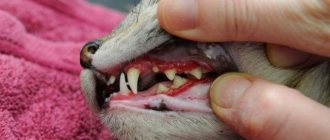Skin diseases are a common occurrence in domestic and farm animals. Pathologies manifest themselves in different ways: hair loss due to attack by parasites, problems with the epidermis and internal disorders. The causes of these symptoms need to be accurately determined. The veterinarian will not only identify the disease, but also prescribe the correct treatment. Some skin diseases can be dangerous to your pet's health.
Causes of sores throughout the body in cats
Damage to the skin is caused by sources of various types. These may be hereditary, infectious or anthropogenic (man-made) factors. The condition of the skin is affected by food changes, poor water quality, or even stress caused by moving to a new place of residence. Scabs, ulcers, and small wounds progress quickly without timely treatment. They cause the pet great discomfort and pain. The cat becomes nervous, scratching the affected areas.
Some ailments do not have obvious manifestations. It is possible to notice pathology only with a thorough examination of the animal. The most obvious is refusal to eat, apathetic state, and constant scratching. The wounds can be of different shapes and colors. They have one thing in common - this is an external manifestation of a serious internal disease.
The main factors may be:
- poor nutrition;
- genetics;
- allergies;
- bacterial and fungal infections;
- blood-sucking or intestinal parasites: ticks, fleas, worms;
- weak immune system.
This diversity means that pathology may well occur in almost any mustachioed friend. There are many specific reasons for this. A specialist in a veterinary clinic can find out the cause of the appearance of ulcers, wounds or scabs, as well as select the correct therapy.
Itching caused by helminths
There are a large number of varieties of parasitic worms that take up residence in a cat’s body. They can be:
- round;
- flat;
- tape.
Usually at the very beginning of infection it is difficult to consider any of its symptoms, but after a while the animal:
- loses appetite and activity;
- becomes restless;
- Constantly licks and itches.
Worms found in the intestines are considered almost harmless.
Difficulties with your pet’s health arise when there are too many helminths and their larvae begin to migrate.
The movement of worms throughout the animal’s body is accompanied by the following symptoms:
- sudden weight loss, increased fatigue, growth retardation in small pets;
- disheveled wool;
- enlarged liver and icteric staining of visible mucous membranes;
- disruption of the digestive system, expressed in constipation, vomiting, diarrhea;
- appearance of cough;
- discharge from the eyes;
- itching in the anus;
- presence of blood in feces;
- premature birth or miscarriage in cats;
- convulsions and paresis of the limbs.
The cat may not notice the presence of parasites in the body in small quantities. However, their increase will not only exhaust the animal, but will also lead to its death. The harm caused to pets by worms can be completely different :
- eating lymph, tissue and blood;
- release of substances that promote intoxication;
- damage to the mucous membranes by suction cups, leading to internal bleeding.
After the worms die, decomposition products are formed that poison the animal’s body.
The appearance of parasites leads to metabolic disorders, as a result of which the cat’s skin becomes dry and dandruff appears on it. Just like an allergic reaction, these factors are accompanied by itching, which causes the animal to scratch its neck until it bleeds. A pet can become infected with helminths in the following ways :
- eating raw meat or fish (especially river fish);
- flea bites;
- contacts with other animals.
To prevent itching, which causes painful scratching, animal owners need to regularly take a preventive course using anthelmintic medications.
Diseases with skin lesions
It is worth taking a closer look at the health problems that cause the uncharacteristic appearance of the skin and coat. Each illness negatively affects the external and internal condition of the pet.
Bacterial and fungal infections
Infections with pathogenic organisms occur in different ways. For example, the dry type of infection causes the appearance of dry, compacted crusts on the surface of the body. The wet form is characterized by redness, ulcers, scratching and severe itching. The reasons for the penetration of infections are varied:
- metabolic disorder;
- diabetes;
- neoplasms of various types;
- weakened immune system;
- superficial wounds.
Treatment is carried out only by a veterinarian after a thorough examination and laboratory tests. One of the most unpleasant and contagious lesions is lichen, which is transmitted to other animals and humans.
It is impossible to choose on your own how to treat a cat’s scratching: to do this, you need to determine the type of pathogen. This can only be done in a veterinary clinic laboratory.
Parasites in cats
One of the most common causes of wounds on a pet’s body is parasites that choose warm areas on its surface. For example, the neck and axillary parts are very attractive to them. Parasites are external blood-sucking pests - fleas or mites, including scabies).
It is not the fleas themselves that cause discomfort, but the products of their activity. The saliva released when a wound is bitten contributes to the onset of allergic irritations. The pet scratches in this area due to severe itching. This is how pathogenic microorganisms appear in the wound, which trigger complications of the disease.
Skin pests are easy to spot. To do this, you just need to examine the body and head of your mustachioed friend. If parasites appear, it is necessary to carry out timely treatment to stop the spread of the infection. In any case, it is important to consult a veterinarian. He will examine the patient and determine that the appearance of sores in the cat is indeed associated with bloodsuckers.
Ticks are much more difficult to see. Subcutaneous individuals are found only by a doctor after a thorough examination and special tests. Treatment is most often prescribed in the form of drops on the withers or tablets. The drug "Ivermek", which is used as intramuscular injections, has proven itself well. The course of injections is 30 days, during which 3 vaccinations are given with a medicinal solution.
A similar product can also be purchased in the form of an ointment or gel. It is applied to the damaged surface after consultation with a veterinarian. Do this at home strictly according to the instructions.
It is important to remember that fleas do not pose a direct threat to your pet's health, but scabies can lead to death. Ticks not only spread under the skin, but also parasitize internal organs, so it is important to start treatment as soon as possible.
Allergic manifestations in cats
Sometimes sores on a cat’s skin occur due to allergies to external irritants. For example, purchasing a new brand of industrial food can lead to malfunctions in the body, which will manifest itself in the form of skin pathologies. It is possible to determine the cause of such a reaction by visual inspection and conducting special tests to recognize the allergen.
In addition to food, the body can react to dust, chemicals or hygiene products. Even inhaling ordinary washing powder leads to unpleasant consequences. There are times when sensitive cats react to blooms. The test, performed in a hospital setting, will identify a group of foods or other substances that need to be removed from the pet. If this is not done, the cat will have to be constantly given medications.
Dermatitis in animals
There are different types of skin dermatitis. Some of them have no complications, while others lead to death if treatment is delayed. They can be both bacterial and fungal, and are also caused by mechanical damage.
The bacterial type of dermatitis manifests itself as ulcers on the body and head of the pet. Animals with weakened immune systems, as well as babies under 1 year old, are at risk of getting sick. Once the pathogen is identified, the doctor prescribes antibiotics.
Less dangerous, but just as unpleasant, are dermatitis caused by seborrhea or injury. In the first case, the cat develops dandruff, and the animal begins to constantly itch in different places. In the second case, a simple wound can fester and cause sepsis, which in many cases leads to death.
Acne on a cat's body
Acne is blackheads with hard crusts. Acne with the appearance of open and closed comedones is usually localized on the neck, chin and lips of the cat. The cause of acne is considered to be poor hygiene, infections, stress, and abnormalities in the sebaceous glands and hair follicles. Even low-quality plastic from which the bowl is made can cause acne. Contact with cheap material can cause unpleasant rashes - it all depends on the sensitivity of the individual.
Another symptom is slight hair loss. If the disease is not treated, ulcers, purulent pimples, inflammation, and bacterial infections appear. After making a diagnosis, the veterinarian prescribes antiseptic detergents: medicated shampoo, soap. In addition, lips, chin and other areas affected by acne are treated with Miramistin or Chlorhexidine.
Other lesions
Even psychogenic factors cause ulcers and crusts on a pet’s body. For example, Cushing's syndrome is manifested by baldness of certain areas of the skin. Fortunately, this syndrome is rare in pets: it appears due to too much of the hormone cortisol. The disease has other pronounced symptoms:
- strong thirst;
- frequent urination;
- constant feeling of hunger with subsequent enlargement of the abdomen;
- lethargy, muscle atrophy;
- thin skin, baldness.
Doctors often prescribe medications that can suppress large releases of cortisol into the blood. In severe cases, the pituitary gland, adrenal gland are surgically removed, or chemotherapy is used.
Another skin problem is alopecia. Loss of fur also occurs under the influence of neuroses. They can be caused by a change of place of residence, the appearance of a new owner, or meeting a new family member. Some breeds are most prone to pathology: these are Abyssinian, Himalayan and Siamese cats.
Baldness is focal. Most often it appears on the abdomen, groin area, sides or inner thighs. Sores rarely appear on a cat's neck. The medications Kot Bayun, Amitriptyline, and Stop-Stress help to cope with the problem.
Allergic reaction as a cause of rashes
Quite often, sores on a cat’s face appear in response to a change in diet. In this case, it does not matter at all what the pet is fed - natural food or dry food. Allergic reactions can occur in any animal, but the risk group includes:
- Kittens up to three months;
- Animals weakened by disease;
- Cats that have recently changed owners;
- Elderly animals;
Allergies in kittens are associated with poor diet. Often the appearance of wounds around the mouth is observed in the first days after the kitten arrives in its new home. This is explained by the fact that the animal’s body is simply not ready to suddenly switch from mother cat’s milk to “adult” food - food, fish, meat.
We recommend the article: What can cause a cat's face to become swollen?
Allergic dermatitis around the mouth can also appear in adult animals that have changed owners. This is primarily due to the stress that the cat experiences in the first days in a new home. The situation gets worse if other animals live in the family. In addition, new owners may simply not know what they fed their pet before, and a sudden change in diet due to stress contributes to the development of an allergic reaction.
A sudden change in the usual diet can also negatively affect the health of a cat that has recently had an illness or an elderly animal. A weakened body will quickly react with an allergic reaction and the appearance of scabs on the furry pet’s face.
The peculiarity of food allergies in cats is the absence of itching. If the sores on a cat’s face do not itch and do not cause any discomfort to the animal, and their appearance is definitely associated with a change in diet, you can be 90% sure that this is a hypersensitivity reaction.
Treating an allergic reaction is easy. It is necessary to give the animal any antihistamine, after consulting with a veterinarian about acceptable dosages. This can also be done over the phone, but only if the owner is sure of the nature of the animal’s rash. Next, you need to change the diet, returning to the cat’s usual food, or replacing the food with hypoallergenic food or gentle natural food.
The danger of skin pathologies for humans
Despite the fact that such diseases are an unpleasant phenomenon, most of them are not transmitted to people. Timely and correct prescription of medications makes them not dangerous for their owners.
Infection with different types of lichen and allergic reactions from blood-sucking bites require the use of medications not only for the animal, but also for the owner. They do not pose a threat to life, but the spread of scabs and ulcers throughout the body of a person or pet is not a very pleasant phenomenon, and it needs prompt treatment.
Can you help your pet yourself?
Mostly, redness and sores on a cat's neck are accompanied by peeling and crusting. For a few wounds, it is recommended to purchase medical sulfur from a pet store and add it to your pet’s food (on the tip of a knife) for 14 days. Fertilizing with sulfur is also carried out for preventive purposes in the spring and autumn.
If the transition to proper nutrition has been made, 10-14 days have passed, and there is no improvement, it is time to consult a veterinarian, because the allergy may be atopic in nature. Then the allergic reaction may be provoked by house dust mites, spring flowering or other environmental factors.
Treatment of skin diseases in cats
Before visiting the hospital, you should prepare to answer questions about your mustachioed friend's condition. The doctor will definitely ask when the ulcers or scabs appeared and ask about diet and seasonal diseases. Having received complete information, the doctor will prescribe special tests and tests:
- biopsy;
- blood analysis;
- scrapings or smears;
- ultraviolet examination.
After laboratory tests, it will not be difficult to understand what caused the cat’s sores throughout the body. Often, a domestic cat is switched to a special diet containing mainly hypoallergenic foods. Vitamin and mineral complexes help restore the immune system. A course of antibiotics is most often accompanied by the use of probiotics to strengthen a weak body.
Sometimes medications can worsen a pet's condition. New symptoms or wounds begin to appear - this is an allergy to medications. In this case, the drugs are discontinued, and new medications are introduced with caution instead. The pet should be constantly monitored so as not to miss any unpleasant responses. If the cat’s condition has not worsened, then the course of therapy should be continued.
Most pet owners try to get rid of severe itching as quickly as possible. Indeed, if you eliminate this symptom, your pet will scratch the skin less and it will begin to heal. If scabs appear on the neck or head, a special collar is put on the animal. Eliminating itching without background therapy cannot be called the correct treatment, because it does not stop the root cause.
Buying medications on your own is strictly contraindicated, because this can lead to deterioration of health. Proper treatment promotes a quick recovery, and regular checks of the cat’s fur will be a good preventative measure against the spread of skin pathologies.
What do the wounds look like?
A fairly common problem in young animals is the appearance of wounds in the lips, eyebrows, and less often on the neck. Most often they are localized around the mouth, which makes it possible to suspect an allergic reaction.
Crusts on and under the ears appear due to dermatitis, lichen, or may be a consequence of otitis media. It is quite simple to distinguish a skin disease from inflammation of the ears - with otitis media, the cat feels pain, does not allow him to touch his head, and pus is released from the ear canal. Inflammatory diseases force the animal to comb its ears to scratches, while with skin pathologies, erosions appear regardless of mechanical impact.
In most cases, the wounds are dense crusts or weeping erosions. In this case, wool grows both from the scab and under it, which can be seen if it is separated from the skin. The disease can be accurately diagnosed only after a series of examinations. First of all, you need to do a test for lichen. In veterinary clinics, this is done by shining a special lamp and examining scrapings from the affected area.
When is hair loss not a cause for concern?
Shedding in a cat is a natural process of hair loss.
If hair loss has become more intense than usual, then first of all you should exclude the usual seasonal shedding.
All representatives of the cat family take very careful care of their fur - they constantly clean and lick it, but when it comes time to replace the old fur with a new one (in spring and autumn), the animals are simply no longer able to cope with proper care for it.
So throughout the apartment, sometimes, in the most unpredictable places, you can find whole clumps of cat hair. To go out neatly, you have to spend a lot of time cleaning your clothes from traces of your pet.
Due to severe itching, your cat may develop scratches and bald spots.
Hair loss and new growth are often accompanied by severe itching . This forces cats to scratch their bodies with their paws and wash themselves more intensively. As a result, small bald spots and scratches remain on the skin, which, however, are quickly restored.
Of course, the situation is not entirely pleasant for the owners, but does not pose any threat to the animals. To cope with it, it is enough to comb your cat daily with a special brush and enrich his daily diet with minerals and vitamins.
Ectoparasites
Human flea dermatitis
Most often, cats suffer from flea attacks. The saliva of blood-sucking insects causes an allergic response characterized by itching. The pet scratches the affected area and flea dermatitis develops.
Microorganisms - permanent inhabitants of the skin - join. The inflammatory process develops according to the scheme described above. Skin parasites - Heyletiella mites feed on the epidermis, causing itching and scratching. Ectoparasites pose a danger to humans. Adult fleas attack people and bite painfully. The larvae crawl from the litter to open areas and feed on the epidermis.
But the greatest harm to humans is caused not by the insects themselves, but by the pathogens of the following diseases, transmitted by all phases of arthropod development:
- brucellosis;
- anthrax;
- typhus;
- helminths;
- tick-borne encephalitis.
Cheyletiella are not so harmful, however, children or old people develop itching after contact with a pet. Ticks cannot stay on cold, hairless human skin for long. If you interrupt contact with your pet, the itching disappears. When restarted it appears again.
Although the biology of parasites is different, the measures to combat them are the same. Adult arthropods and larvae are destroyed with an insectoacaricidal spray. After 8-10 days the treatment is repeated.
Drops of Stronghold
Eggs are immune to poisons. After 8-10 days, the larvae hatch from them, so you need to destroy them before they become sexually mature. External anti-inflammatory wound healing agents are applied to the damaged surface. To speed up healing, pets are switched to veterinary food for cats with skin diseases.
Prevention consists of regular use of Spot-on drops, which protect against ectoparasites and worms.











